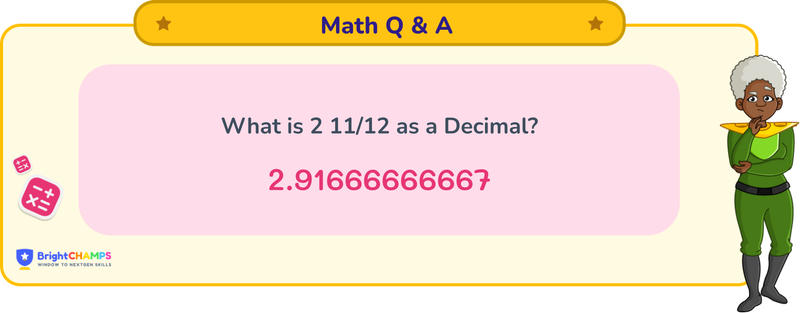
 149 Learners
149 LearnersLast updated on May 26th, 2025

2 11/12 as a Decimal

It is a simple question on decimal conversion. Firstly, we have to learn fractions and decimals. A fraction represents a part of the whole. It has two parts, numerator (number on the top) here, 11 represents how many parts out of the whole. The denominator (number below) shows how many parts make the whole, here it is 12. A decimal is a way to represent a number that is not whole, using a (.) or a decimal point to separate the whole part from the fraction part. The numbers to the left of the decimal point represent the whole, and those to the right represent the fractional part.
What is 2 11/12 as a decimal?

Answer
2 11/12 in decimal form is 2.91666... It is a recurring decimal, indicating that the digit 6 repeats infinitely.
Explanation
To convert 2 11/12 into a decimal, we will first convert the fractional part 11/12 into a decimal using the division method. After that, we will add the whole number part. Let's break down the process:
Step 1: Identify the numerator and denominator. The numerator (11) will be the dividend, and the denominator (12) will be the divisor.
Step 2: Divide 11 by 12. Since 11 is smaller than 12, we will use decimals to perform the division.
Step 3: Add a decimal and a zero to the dividend, making it 110.
Step 4: Divide 110 by 12. The closest multiple of 12 less than 110 is 108 (12 × 9), so we write 9 in the quotient. Subtract 108 from 110, resulting in 2.
Step 5: Bring down another 0, making it 20. Divide 20 by 12. The closest multiple is 12 (12 × 1), so write 1 in the quotient. Subtract 12 from 20, resulting in 8.
Step 6: Bring down another 0, making it 80. Divide 80 by 12. The closest multiple is 72 (12 × 6), so write 6 in the quotient. Subtract 72 from 80, resulting in 8.
Step 7: Repeat the process, as 8 becomes 80 again. The division process will continue, and we get a repeating decimal. Therefore, 11/12 as a decimal is 0.91666..., and adding the whole number part, 2, we get 2.91666...
Struggling with Math?
Get 1:1 Coaching to Boost Grades Fast !

Important Glossaries for 2 11/12 as a decimal
- Fraction: A numerical quantity representing a part of a whole, consisting of a numerator and a denominator.
- Decimal: A number that uses the base ten and includes a decimal point to separate the whole part from the fractional part.
- Numerator: The top part of a fraction, indicating how many parts of the whole are being considered.
- Denominator: The bottom part of a fraction, showing how many parts make up a whole.
- Recurring Decimal: A decimal in which a digit or group of digits repeats infinitely.




